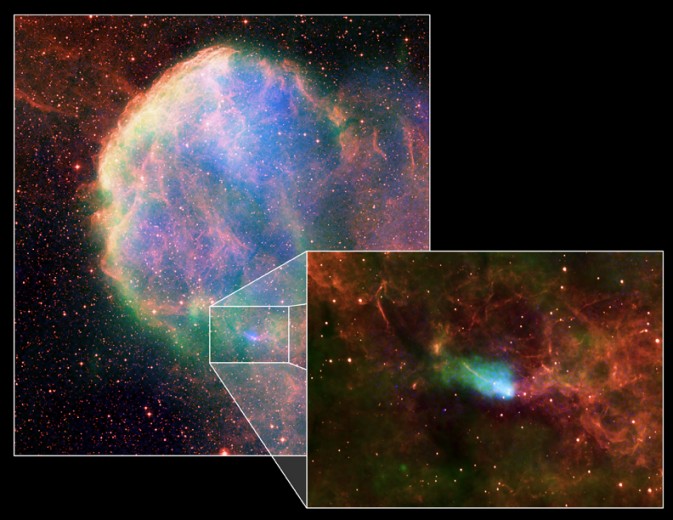APOD.pl: astronomiczne zdjęcie dnia
Codziennie nowy obraz lub zdjęcie naszego fascynującego Wszechświata
wraz
z krótkim objaśnieniem napisanym przez zawodowego astronoma.
Zobacz więcej!

Źródło: Chandra X-ray: NASA/CXC/B.Gaensler et al; ROSAT zakres rentgenowski: NASA/ROSAT/Asaoka i Aschenbach;
radio szeroki kąt: NRC/DRAO/D.Leahy; radio szczegóły: NRAO/VLA; zakres optyczny: DSS
Opis: IC 443 jest typową pozostałością gwiezdnego wybuchu, końcowe przeznaczenie masywnej gwiazdy. Widoczne w sztucznych barwach powyższa mozaika pozostałości supernowej wciąż świeci w całym zakresie widmowym, od fal radiowych (błękit), poprzez zakres optyczny (czerwień) do energii rentgenowskich (zieleń) -- i to pomimo tego, że światło z tego gwiezdnego wybuchu, który wytworzył ów rozprzestrzeniający się kosmiczny obłok, dotarło na Ziemię po raz pierwszy tysiące lat temu. Dziwnym faktem, związanym z IC 443 jest pozorny ruch jej gęstej gwiazdy neutronowej, zapadniętej pozostałości jądra gwiazdy. Zbliżenie we wstawce pokazuje cofnięty ślad, wytworzony, gdy gwiazda neutronowa przebija się przez gorący gaz, lecz jego kierunek nie pokrywa się z kierunkiem ku widocznemu środkowi pozostałości. Ta niewspółosiowość sugeruje, że miejsce wybuchu było przesunięte względem środka lub że szybko poruszający się gaz w mgławicy zaburzył ów ślad. Powyższy szeroki widok IC 443, znany również jako Mgławica Meduza obejmuje około 65 lat świetlnych, przy szacowanej odległości do tej pozostałości supernowej na 5000 lat świetlnych.
Jutro: Ziemia w promieniach gamma
< | Archiwum | Lista tematyczna | Szukaj | Kalendarz | Słownik | Edukacja | O APOD | Forum | >
Autorzy i wydawcy:
Robert Nemiroff
(MTU) &
Jerry Bonnell (UMCP)
NASA Official: Phillip Newman
Specific rights apply.
NASA Web
Privacy Policy and Important Notices
A service of:
ASD at
NASA /
GSFC
& Michigan Tech. U.